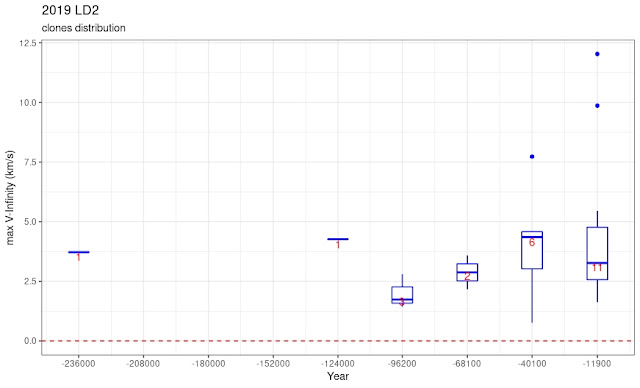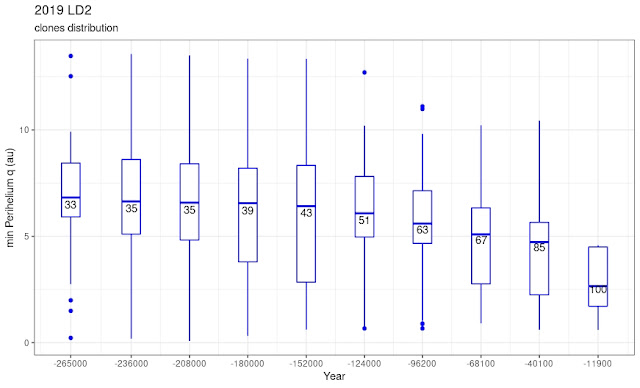See Sam Deen's post on MPML
JPL Small-Body Database Browser
| (2020 MK4) |
| Classification: Centaur SPK-ID: 54028098 |
[ show orbit diagram ]
Orbital Elements at Epoch 2459000.5 (2020-May-31.0) TDB
Reference: JPL 4 (heliocentric ecliptic J2000)
| Element | Value | Uncertainty (1-sigma) | Units | | e | .02195188337952747 | 0.00026496 | | | a | 6.158612875846196 | 0.00097828 | au | | q | 6.023419724215964 | 0.0020101 | au | | i | 6.667359451314571 | 0.00055296 | deg | | node | 2.340270538083764 | 0.0080184 | deg | | peri | 176.0179742158394 | 0.82761 | deg | | M | 112.9081690495819 | 0.85696 | deg | | tp | 2457249.663268073103
(2015-Aug-15.16326807) | 12.903 | TDB | | period | 5582.423564205491
15.28 | 1.3301
0.003642 | d
yr | | n | .06448811987472979 | 1.5366e-05 | deg/d | | Q | 6.293806027476427 | 0.00099976 | au |
|
| | Orbit Determination Parameters
Additional Information |
Backward simulation
100 clones generated:
|
Clones | |
Target |
|
mean |
sd |
|
mean |
sd |
|---|
| q |
6.02351360763 |
0.00201082117 |
|
6.02341972422 |
0.0020101 |
| e |
0.02194045805 |
0.00026498393 |
|
0.02195188338 |
0.00026496 |
| i |
6.66737828519 |
0.00055323416 |
|
6.66735945131 |
0.00055296 |
| peri |
176.0244406455 |
0.82839257994 |
|
176.01797421584 |
0.82761 |
| node |
2.33984409116 |
0.00803481217 |
|
2.34027053808 |
0.0080184 |
| tp |
2457249.73101293 |
12.90996695426 |
|
2457249.66326807 |
12.903 |
The simulation was performed with Mercury6 simulator from J. E. Chambers.
The time interval from now back to 180K years ago was investigated.
The following clones appear yo have a cometary origin because they entered the solar system from a distance greater than 100 AU:
MK87 ejected at -3992 10 15.95739
MK25 ejected at -11386 5 6.63099
MK69 ejected at -11668 7 18.91268
MK65 ejected at -13267 1 2.82563
MK66 ejected at -13674 4 27.93527
MK57 ejected at -18216 12 4.27966
MK16 ejected at -22393 11 16.92234
MK56 ejected at -24538 5 23.00058
MK100 ejected at -24872 11 3.71037
MK33 ejected at -25672 8 29.33118
MK14 ejected at -26908 10 12.16609
MK79 ejected at -27042 1 10.47236
MK59 ejected at -27477 5 21.28744
MK41 ejected at -28193 12 31.77309
MK50 ejected at -28229 6 24.30764
MK70 ejected at -30832 2 18.82571
MK86 ejected at -33366 10 3.35722
MK83 ejected at -36505 4 22.99516
MK11 ejected at -42971 5 25.41050
MK52 ejected at -43914 6 24.36384
MK15 ejected at -45152 10 31.83684
MK75 ejected at -46261 3 18.78421
MK20 ejected at -46400 2 13.00000
MK24 ejected at -52981 8 4.81971
MK39 ejected at -54008 2 8.41040
MK44 ejected at -54032 5 23.55889
MK36 ejected at -56218 3 9.00000
MK13 ejected at -58238 6 27.08479
MK58 ejected at -61702 8 22.73425
MK73 ejected at -63075 1 20.75482
MK63 ejected at -65472 1 22.91155
MK98 ejected at -69333 10 24.33742
MK19 ejected at -70475 6 20.82479
MK43 ejected at -76905 9 26.09250
MK78 ejected at -81576 4 16.15310
MK5 ejected at -81766 3 24.20996
MK27 ejected at -81906 2 20.04496
MK88 ejected at -82300 11 9.76100
MK84 ejected at -82695 7 11.00000
MK53 ejected at -83313 4 14.51728
MK64 ejected at -85820 2 27.87065
MK51 ejected at -86401 8 29.32042
MK7 ejected at -90081 6 21.71342
MK61 ejected at -94034 3 26.84777
MK10 ejected at -95133 10 16.26793
MK92 ejected at -96254 6 24.13705
MK68 ejected at -97012 6 11.67088
MK21 ejected at -97348 9 22.80596
MK34 ejected at -97977 4 4.52762
MK90 ejected at -105289 3 9.80638
MK32 ejected at -107468 8 18.14496
MK3 ejected at -110733 12 20.80791
MK40 ejected at -113571 10 4.91780
MK76 ejected at -116794 4 30.66382
MK38 ejected at -122623 3 31.58393
MK8 ejected at -123524 2 13.51981
MK80 ejected at -124886 5 8.57397
MK9 ejected at -141230 12 15.21267
MK91 ejected at -142117 5 23.59862
MK97 ejected at -151011 6 25.85088
MK82 ejected at -158864 10 19.14006
MK81 ejected at -160420 4 20.25107
was hit by MK17 at -168177 7 5.2
MK31 ejected at -176722 11 5.97609
Cheers,
Alessandro Odasso












